| Article Overview:
The Dogs of War are really the K-9's of Vigilance. They
are the War Dogs used in Iraq, Vietnam, Korea, World War II to sniff
out the Beast of Terror. They helped win the war in Iraq, but
they serve a much greater purpose. They are reminders we need to
stand sentry against Terrorism to defeat it. |
 VigilanceVoice VigilanceVoice
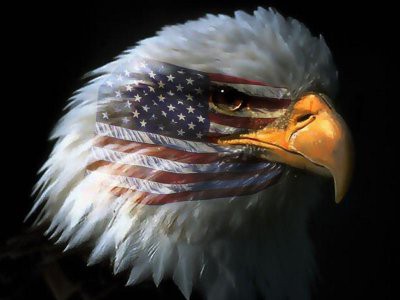
www.VigilanceVoice.com
Thursday--April
17, 2003—Ground Zero Plus 582
___________________________________________________________
The Dogs Of War Howl In The Aftermath of Victory
___________________________________________________________
by
Cliff McKenzie
Editor, New York City Combat Correspondent News
|
GROUND ZERO, New York City, Apr. 17--As the war in Iraq winds to an
end the yips and howls of some of the toughest combat veterans can be
heard barking in joy.
They are the combat dogs, usually German
Shepherds and Belgian Malinois, who have uncanny abilities to sniff
out both the enemy and the enemy's weapons.
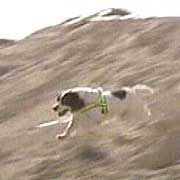 |
|
Buster in
action |
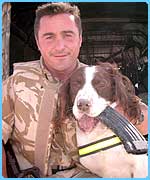 |
|
Buster,
Springer Spaniel War Dog hero in Iraq |
One such dog, Buster, rooted out weapons hidden in a wall cavity
covered with a sheet of tin that coalition troops had already searched
and cleared.
"War Dogs" have the ability to "smell" the
enemy up to 250 yards away, and can detect sounds even when challenged
by the roar of an F-14 jet engine.
The use of War Dogs is ancient.
Roman centurions captured wild dogs and used them to fight one
another, and the most vicious were then trained to attack the enemy in
battle. In the U.S. Revolutionary War dogs were used as
messengers and scouts.
In Vietnam more than 4,000 War
Dogs are credited with preventing over 10,000 U.S. casualties based on
their instinct to alert their handler to danger. One of the more
famous stories of that war involves a War Dog named Bruiser, a German
Shepherd.
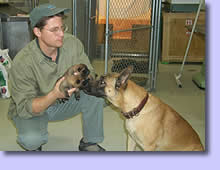 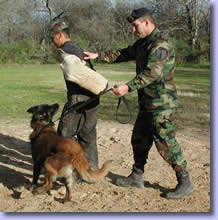 |
|
Training dogs
for Vietnam |
Bruiser and his handler were on patrol when Bruiser froze, his ears
cocked, signaling the presence of the enemy. His handler,
John Flannelly, began to fire, exposing an enemy ambush.
Gravely wounded, Flannelly was sure
this was the end. Bruiser had other ideas. The
shepherd dragged Flannelly to safety, suffering two wounds in the
process. The canine's advanced warning helped U.S. forces
limit casualties and credited the dog with saving a number of lives.
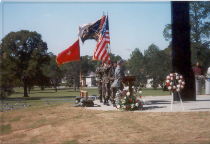 |
| Go to: www.war-dogs.com |
The center for War Dog training is Lackland Air Force Base in San
Antonio, Texas. (link
http://dodmwd.lackland.af.mil/
)
Dogs are selected from breeders both in the U.S. and Europe, trained
at the center, then disbursed to all branches of the military. A
War Dog Memorial Fund is located at March Field Air Museum in
Riverside, California. Mo Johnson, a member of the Fund, says
his goal is to establish to memorials, one on the East and the other
on the West Coast of America. The unveiling of another War Dog
Memorial on Sacrifice Field at Fort Benning, Ga. took place on October
8, 2000 (photo on left).
Until Nov. 5, 2000 when H.R. 5314 was
passed authorizing their adoption by qualified personnel, combat dogs
were exterminated. Based on their aggressive
training, they were considered a threat to the safety of the public.
Currently, when a War Dog is retired, if it
meets certain standards of domesticated behavior, it is eligible for
adoption by a qualified handler--generally a former dog handler, or
someone experienced in working with highly trained, aggressive
canines.
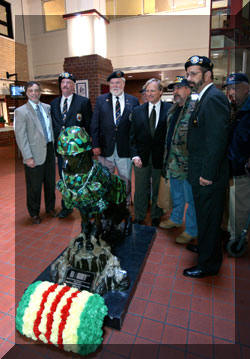 |
|
DogNY created and displayed
300 statues around New York City as a
tribute to the dogs that assisted in Nine Eleven. The
above statue, a tribute to military dogs, is owned by the
Vietnam Veterans Assn. and is displayed throughout the
country |
Canines are used not only in combat as sentries, but also to sniff out
drugs, explosives and in rescue efforts.
War
Dogs were not part of the official military mix until the attack on
Pearl Harbor, launching World War II. Prior to Pearl
Harbor, the U.S. had noted France, Germany and Belgium's use of dogs
in World War I, but found no use for them in its Armed Services.
After Pearl Harbor, the threat of
enemy submarine landings on U.S. coasts alerted the need for
additional security, and to protect industrial plants from sabotage.
Civilians offered their help under a program called Dogs for Defense.
Volunteering their animals, and working for no pay, civilians began
patrolling the beaches. However, the program failed to meet
military expectations.
On July 6, 1942, the military took
seriously the use of War Dogs, employing 100 sled dogs in Alaska and
another 100 in "basic training" for scout and sentry use.
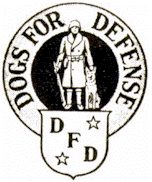 |
A well-known woman dog breeder and dog show judge, Mrs. Milton
Erlanger, the key energy behind Dogs for Defense, authored the first
instructions on using canines for security. Her work was a
training manual known as TM 10-396-WAR
DOGS. She also produced technical bulletins and training films.
Originally, more than 30 breeds were
used as sentry and guard dogs, but many breeds were not suited for the
job, such as Great Danes and hunting dogs often thrown off by animal
scents. By 1944 the list of acceptable dogs included only
the following: German Shepherds, Belgian sheep dogs,
Doberman-Pinschers, farm collies, Siberian huskies, Malamutes and
Eskimo dogs. The chart below shows how the 10,000 Defense Dogs
were utilized in WWII
Type and Number of Dogs Trained
| Type of Dog |
Trained for
Army |
Trained for
Coast Guard |
Total |
| Sentry |
6,121 |
3,174 |
9,295 |
| Scout |
571 |
0 |
571 |
| Sled and pack |
263 |
0 |
268 |
| Messenger |
151 |
0 |
151 |
| Mine detection |
140 |
0 |
140 |
|
Sentry dogs worked in
silence. They were trained to alert their handlers of ambushes
or infiltration of the enemy. When the dog "winded the
enemy" he would stiffen, raise his hackles, point his tail.
No sounds could be emitted.
Messenger dogs
were trained by two handlers. One of the handlers would be
in the front and the other in the rear. Both lavishly
praised the dog and became their "dual masters." In combat, when
the handler in the front put a message in the dog's collar, the dog
would seek out its "other master" in the rear, following the scent as
a bloodhound. Enemy fire and combat confusion didn't waver
the dog from its goal, and it would find its "dual master," receiving
big hugs and pets as the message was removed.
| STUBBY,
Bull Terrier mix, WWI.
The most decorated war dog in U.S. history.
As a small, stray bull terrier, he was
smuggled aboard a troop ship to France. There he was wounded in
no-man's land but recovered and still served in battles at Chateau
Thierry, the Marne and the Meuse-Argonne with the men of the 102nd
Infantry. One night in February 1918, he roused a sleeping
sergeant to warn of a gas attack, giving the soldiers time to don
masks and thus saving them. Gen John "Black Jack" Pershing awarded
him a special Gold Medal. He was given Life Membership in the
American Legion and the Red Cross. He met Presidents Wilson,
Harding, and Coolidge. He died of old age in 1926. Stubby is now
on display as part of American military history in the Hartford
Armory in Connecticut and is called "Sargeant Stubby".
|
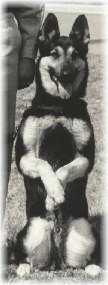 PRINCE
347E, German Shepherd,Vietnam
(see photo).
He served our country his entire adult
life and was put to rest on October 2, 1968, at the War Dog
Hospital, Long Binh, Vietnam. "I have remembered him every day for
the last 39 years and will continue to do so until I join him.
Thank you very much for honoring those that the
military/politicians in DC forgot so many years ago." - Robert L.
Ott, Initial Trainer and Handler PRINCE
347E, German Shepherd,Vietnam
(see photo).
He served our country his entire adult
life and was put to rest on October 2, 1968, at the War Dog
Hospital, Long Binh, Vietnam. "I have remembered him every day for
the last 39 years and will continue to do so until I join him.
Thank you very much for honoring those that the
military/politicians in DC forgot so many years ago." - Robert L.
Ott, Initial Trainer and Handler |
|
go to:
www.eagleid.com/post127/dogs.htm
and read about other war dogs |
War Dog
Platoons were formed in WWII, comprising 12 scout dogs, 12 messenger
dogs, one mine detection dog, one office and 26 enlisted men.
Later, when the mine detecting dogs proved ineffective in rooting out
enemy mines, the mix was enhanced to 18 scout and 6 messenger dogs.
America enjoys nearly 40 million dogs as pets,
about .361 per household--(there are more than 100 million U.S.
households).
In Iraq, the stories of how canines saved lives
has yet to be told. It may take a few decades for all the
tales to be told, and many may yet to be unfolded because the canine's
full use is yet to come. Guarding Iraq may prove a far
greater challenge than winning the war. Digging through the
rubble, protecting against possible insurgents and guerrilla force
threats, sniffing out mines and buried explosives--all full-time work
for dogs trained to provide both sentry and to ferret out dangerous
weapons.
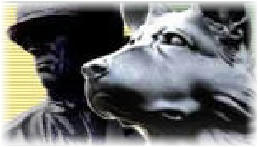 |
|
K-9 Sentry of
Vigilance |
While
America is basking in the glow of victory, there are many stories yet
that will rise out of the ashes of Iraq.
The Dogs of War will certainly be one of
them.
I think of the dog as a Sentinel of
Vigilance--a K-9 Sentry of Vigilance, if you will.
Trained properly, the K-9 Sentry of
Vigilance, can sniff the Beast of Terror, catch his scent in the wind
just as quickly as he might an enemy.
 |
The K-9 Sentry of Vigilance can smell the Fear, Intimidation and
Complacency that worms its way into the minds of the people, that
makes them vulnerable to the Beast's venom.
War itself is the result of Terrorism's
infiltration into the marrow of a society. War is the end
result of letting Terrorism run free, the kind of Terrorism that
threatens, bullies and brandishes weapons of mass destruction that
threaten the security of an entire world.
When nations sit back and let other nations
violate human rights and defy international law under the false
security of sovereignty, it is not unlike the ostrich burying its head
in the sand. Ignorance is not bliss, it is eventual
Terrorism of the worst kind.
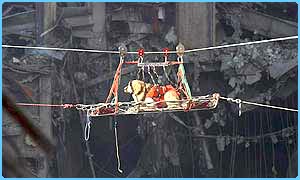 |
|
Nine-Eleven
Sentry of Vigilance |
If
the world community, specifically the United Nations, were a sentry
dog, it would sniff out the Beast. It would raise it hackles.
Its body would stiffen. Its ears would flatten.
It would tell the world that the Beast of
Terror was laying in ambush, waiting to spring out on the
unsuspecting.
The U.S. used its Dogs of War to sniff out
Saddam Hussein. Despite the world's refusal to back the
U.S., Britain and Australia, the War Dogs attacked the Beast while
others hid behind the shield of Indifference, and wallowed in the
Quagmire of Complacency.
Now, the Dogs of War are barking.
 |
|
K-9 Sentinels
of Vigilance are barking a warning |
They
are barking not in joy of defeating Terrorism.
They are barking as a warning to not let
the next Beast of Terror go unnoticed.
As K-9 Sentinels of Vigilance, they are
telling the world to beware--the enemy is not dead and buried.
They remind us all to keep our nose to the
ground, sniffing, searching, patrolling and being ready to root out
Terrorism before it swallows us.
Hail the Dogs of Vigilance. Let
them keep us and our children safe.
|
War Dog
Memorials and Tributes |
April
16--War Vultures Swoop Down On Weapons
©2001
- 2004, VigilanceVoice.com, All rights reserved -
a ((HYYPE))
design
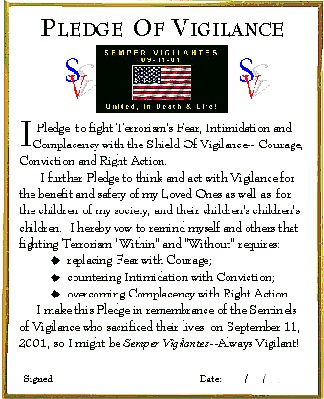
|
| |
|
|